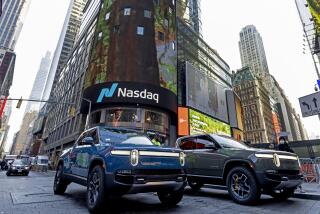Mapping GM’s Route to Recovery
- Share via
Addressing shareholders at General Motors Corp.’s annual meeting last year, Chairman and Chief Executive Rick Wagoner had only grim news.
The world’s largest automaker had lost $1.1 billion in the first quarter of 2005. Its crucial North American automotive business was losing market share to competitors such as Toyota Motor Corp. and was swamped by staggering healthcare costs for employees and retirees.
Wagoner at the time estimated that so-called legacy costs added $1,500 to the price of every car and truck GM made in the United States.
To get back on track, Wagoner said, GM would have to close factories, dramatically pare its blue-collar payroll in the U.S. and Canada and revise its health plans so that employees -- union and salaried alike -- would shoulder more of the cost.
Since that first announcement a year ago, Wagoner has undertaken a determined turnaround effort.
GM ended up losing $10.6billion in 2005, and despite a $445-million profit for the first quarter of this year it continues losing money in North America.
That has some critics saying that GM’s chief hasn’t done enough and that the automaker is running on fumes. Others have seen signs of recovery. Indeed, GM’s share price has climbed more than 36% this year -- the largest gain of any stock in the Dow Jones industrial average -- on optimism that the automaker’s tank may be filling rather than emptying.
As he prepared late last week for this year’s annual meeting Tuesday, Wagoner discussed with The Times his company’s progress, his own performance and his expectations for the future.
Question: How far along are you in achieving your recovery goals?
Answer: We set an objective of reducing our annual structural costs by $6 billion as of the end of 2006, and we now have raised that to $7 billion based on all we have been able to do. The progress in savings is significantly in excess of what people expected.
But there’s certainly more to do.
Q: You’ve just appointed GM Asia-Pacific President Troy Clarke to take over from you as president of GM North America. What are your expectations of him?
A: To do what he’s done in prior positions. He’s shown excellent leadership skills. I’m looking for him to drive the day-to-day business and work with all of us as we continue to plot the strategic steps to keep driving the North American turnaround on a fast or, ideally, faster, pace.
Q: GM’s contract with the United Auto Workers union is up for renewal next year. Clarke formerly was head of North American labor relations. Was that a big factor in his appointment?
A: As I thought about the person for the job, I didn’t say I needed a labor expert. But certainly his track record is going to be helpful.
Q: Will there be other key executive changes at GM related directly to the recovery?
A: You can never rule out more changes, but I think the significant high-level moves we’ve done already should position us pretty well for a while.
Q: You took on the job of North American president last year and now are relinquishing it. But you remain chairman and chief executive. There are rumblings that the newest member of your board of directors, Jerome York, has suggested that he would make a good nonexecutive chairman.
Is the chairmanship important to you?
A: The tradition at GM has been to have a [combined] chairman and CEO position. But the board has the primary input, and beyond that there’s not anything that I can add. But there is a shareholder proposal [on the annual meeting agenda] to make the chairman a separate person again, so we’ll have to see how that goes.
Q: What do you say to critics who question your abilities to lead GM out of the wilderness?
A: I’m just staying focused on executing the job at hand. We’ve obviously made a lot of tough, important moves, in some ways breakthrough moves -- for instance, our negotiated healthcare deal with the UAW.
I’m just 100% focused on doing what’s right for the company and getting the business into a position that is not just profitable but really able to compete in the global world we are in. And I don’t really worry about the rest.
Q: You’ve said that to be profitable, GM must shrink its North American operation. What’s the right size?
A: We haven’t set market share targets. We are obviously taking a hit as we transition to a more retail-oriented sales strategy, but we think that’s the right thing to do. We’ve had to fight for every sale we can at the retail level, and we’re going to keep doing that.
Q: The UAW has said that it expects about 30,000 workers to sign up for your buyout plan by the June 23 deadline, which would certainly accelerate your goal of achieving that number by 2008. But is 30,000 going to be enough?
A: We’re hoping this earlyattrition program will enable us to achieve our target of 30,000 sooner. I reserve judgment as to what happens after that.
Q: For many analysts, a big guessing game now is when Toyota will surpass GM as the world’s largest automaker. Is the No. 1 position important to you?
A: We’ve been there a long time, and it is a position we like. I’d be less than honest to say that we don’t care. Within the context of where the company is today, though, our focus and energies are all about the turnaround plan and the growth plans in Asia, Latin America, Africa and the Middle East. We will try to get the most volume we can, but we cannot control what the competitors do.
Q: What about GM’s global growth plans?
A: Last year was the second-highest sales volume in GM’s corporate history. It was the first year we sold more units outside the U.S. than in. And again this year we had all-time GM sales records for the first quarter in Asia and Latin America, Africa and the Middle East. So we are growing well and we’re going to keep pushing that.
Q: Do you expect that selling more outside the U.S. than in is going to be the norm now?
A: Sure. It’s like, “Why do you rob banks? Because that’s where the money is.” We see economies, particularly in Asia, growing faster, incomes rising at a faster rate, more people entering into the income range where they can afford to begin to buy vehicles. And that’s clearly an opportunity, if we do it the right way, where we can really grow our position and make some good money doing it.
Q: You’ve complained that in this country you’re the Rodney Dangerfield of the car industry. You just can’t get any respect. Your message is that you deliver quality and fuel economy that matches the competition, but there’s still a lot of skepticism. Why? What more do you have to do to sell your message?
A: We have to do a good job of telling our story, but in the end it’s results that are going to sell. So we have to deliver quality and get consumers into our products to see for themselves. Sometimes we’re frustrated because it takes longer than we like.
Our assignment is to keep driving product execution so we offer cars and trucks that people get excited about, to tell the story of those products and to deliver better results so we can get some of the focus off of the restructuring and onto exciting products, which is really what matters to most consumers.






